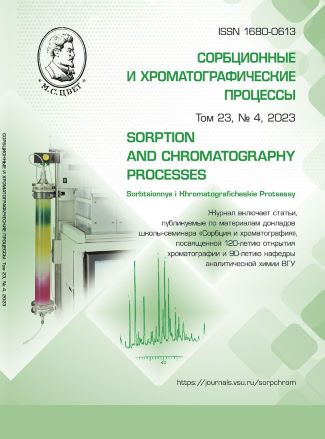Assessment of the possibility of the prediction and regulation of sorption properties of composite coatings of piezoquartz sensors
Abstract
The synthesis and application of new compounds as sorbents, including in the creation of sensors, is rapidly developing. To ensure high performance characteristics in combination with sensitivity and selectivity, various approaches are used to create composite sensor coatings. The study of sorption processes is the basis for the creation and development of analytical application of gas sensor systems, including those based on piezoquartz resonators. When developing new coatings for their further successful analytical application, it is important to create a model or theory for predicting their sorption properties. Therefore, the study is devoted to assessing the possibility of predicting the sorption properties of composite coatings of piezoquartz sensors based on sorbents of various natures.
As sorbents for the formation of sorption films and composite coatings (in the ratio of 1: 1 by weight, designation (sorbent1+sorbent2)) on the electrode surface of piezoquartz resonators (PCR) with a base oscillation frequency of 14.0 MHz, substances of different nature (chitosan, 18-crown-6, amorphous silicon oxide, lanolin, dihydroquercetin, carbon nanotubes, micellar casein concentrate (MCC)) were used. The study of sorption of compounds on individual and composite coatings of sensors was carried out in static mode using a MAG-8 device. As the sorption properties of coatings, the characteristics reflecting the efficiency (specific mass sensitivity) and kinetics (desorption coefficient, sorption rate) of the sorption of substances were calculated. The method of projections onto latent structures was used for the prediction of the sorption properties of coatings. As a result of the research, the previously established influence of the degree of dispersion of the sorbent on the mass sensitivity of the micro-weighing of vapours of substances was confirmed, with an increase in particle size, the specific mass sensitivity increased. It has been shown that an increase in the specific mass sensitivity of the microweighing of substance vapours using composite coatings (MCC + stabilizing sorbent) was observed with an increase in the affinity of the stabilizing sorbent for water vapour. Moreover, with an increase in the length of the hydrocarbon radical by C2H5- in a homologous series of carboxylic acids and alcohols, the rate of increase in the specific mass sensitivity of microweighing increased by an order of magnitude. Also, with an increasing polarity of sorbed compounds, the sorption rate increased on all composite coatings (MCC + stabilizing sorbent). It has been established that the specific mass sensitivity of the microweighing of substance vapours on chitosan-based composite coatings increased for vapours of volatile compounds with a small hydrocarbon radical with increasing affinity of the sorbent for water. Also, with an increasing polarity of sorbate molecules, the rate of sorption on all composite coatings based on chitosan decreased, which is consistent with the change in the rate of sorption on its individual film. An approach was proposed for assessing the sorption characteristics of composite coatings based on the considered types of sorbents with the determination of coefficients using the regression method on latent structures with an error of 5%. The considered trends in changes in the sorption properties of coatings depending on various factors can be used to create composite coatings of gas piezosensors with specified sorption properties.
Downloads
References
Combinatorial Methods for Chemi-cal and Biological Sensors, ed. RA Potyrailo and VM Mirsky. 2009: 135.
Nikolic MV, Milovanovic V, Va-siljevic ZZ, Stamenkovic Z. Semiconductor Gas Sensors: Materials, Technology, De-sign, and Application. Sensors. 2020; 20(22): 6694. https://doi.org/10.3390/s20226694
Blue R., Uttamchandani D. Chemi-capacitors as a versatile platform for miniature gas and vapor sensors. Meas. Sci. Technol. 2017; 28: 022001. https://doi.org/10.1088/1361-6501/28/2/022001
Sadeghian R.B., Kahrizi M. A novel miniature gas ionization sensor based on freestanding gold nanowires. Sensors and Actuators A: Physical. 2007; 137(2): 248-255. https://doi.org/10.1016/j.sna.2007.03.010
Savaloni H., Savari R., Abbasi S. Application of Mn nano-flower sculptured thin films produced on interdigitated pat-tern as cathode and anode electrodes in field ionization gas sensor. Current Applied Physics. 2018; 18(8): 869-878. https://doi.org/10.1016/j.cap.2018.04.017
Sichani S.B., Nikfarjam A., Hajghassem H. A novel miniature planar gas ionization sensor based on selective growth of ZnO nanowires. Sensors and Ac-tuators A: Physical. 2019; 1: 55-60. https://doi.org/10.1016/j.sna.2019.01.024
Lagutin, A.S., Vasil’ev, A.A. Solid-State Gas Sensors. J Anal Chem. 2022; 77: 131-144. https://doi.org/10.1134/S1061934822020083
Kuchmenko T.A. Metod p'ezo-kvarcevogo mikrovzveshivaniya v gazovom organi-cheskom analize. Dis…d-ra. him. nauk. Voronezh, 2003. 473 p. (In Russ.)
Kuchmenko T.A., Asanova Y.A., Molchanov V.I. Effect of solvent on the adsorption of benzene vapors by dicyclo-hexane-18-crown-6 thin films. J Anal Chem. 2009; 64: 354-360. https://doi.org/10.1134/S1061934809040066
Karlov P.A., Kuchmenko T.A. Izuchenie sorbcionnyh svojstv modificiro-vannyh MUNT k param organicheskih soedinenij. Sorbtsionnye i khromato-graficheskie protsessy. 2022; 22(4): 512-522. https://doi.org/10.17308/sorpchrom.2022.22/10606 (In Russ.)
Shuba, Anastasiia, Tatiana Kuchmenko, and Ruslan Umarkhanov. 2022. "Piezoelectric Gas Sensors with Pol-ycomposite Coatings in Biomedical Appli-cation" Sensors 22, no. 21: 8529. https://doi.org/10.3390/s22218529
Shuba A., Kuchmenko T., Umarkhanov R. Bogdanova E. Composite Coatings of Piezoelectric Quartz Sensors Based on Viscous Sorbents and Casein Mi-celles Conference Proceedings, Istanbul Türkiye April 24-25, 2023 XVII. interna-tional research conference proceedings P. 1-4.
Sayerbrey G., Messung Von Plat-tenschwingungen Sehr Kleiner Amplitude Durch Lichtstrommodulation. Zeitschrift Fuer Physik. 1964; 178: 457-471.
Karimzadeh, Ayub, Mohammad Hasanzadeh, Nasrin Shadjou, and Miguel de la Guardia. "Peptide based biosen-sors." TrAC Trends in Analytical Chemis-try. 2018; 107: 1-20.
Tianwei T., Liu Y., Jiang Y. "Re-cent progress on highly selective and sensi-tive electrochemical aptamer-based sen-sors." Chemical Research in Chinese Uni-versities. 2022; 38(4): 866-878.







